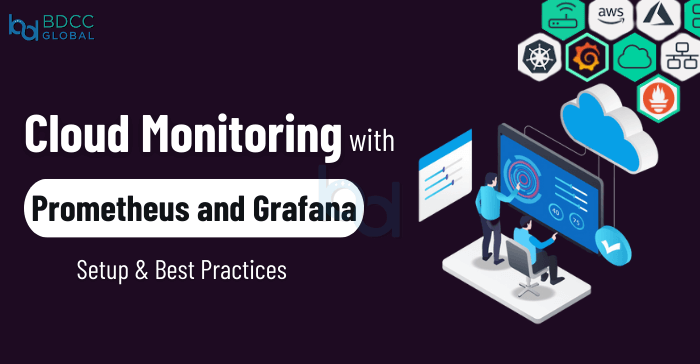
In today’s cloud-native era, infrastructure monitoring has become more than just a support function; it’s the core of performance, uptime, and reliability. Organizations are increasingly adopting open-source observability tools to monitor their systems efficiently. Among them, Prometheus and Grafana stand out as a powerful combination for cloud monitoring.
If you’re building scalable applications on the cloud, setting up real-time visibility into your infrastructure is non-negotiable. This blog takes a deep dive into how you can implement Cloud monitoring with Prometheus and Grafana, from setting them up to creating meaningful dashboards.
Why Monitoring Cloud Infrastructure Matters?
Modern applications run on distributed, dynamic, and containerized environments. From Kubernetes clusters to serverless functions, every component generates metrics that can help detect issues before they impact users. But to leverage those metrics, you need to:
- Collect them efficiently
- Store them with minimal overhead
- Visualize them meaningfully
- Alert on anomalies
That’s exactly where Prometheus and Grafana shine.
What is Prometheus?
Prometheus is an open-source systems monitoring and alerting toolkit originally built by SoundCloud. It’s designed to collect metrics from your services and store them in a time-series database.
Key Features
- Pull-based metrics collection via HTTP endpoints
- Multidimensional data model (labels, key-value pairs)
- Built-in query language (PromQL)
- Alerting via Alertmanager
- Seamless integration with Kubernetes, Docker, and cloud services
What is Grafana?
Grafana is a powerful visualization and analytics tool that integrates with Prometheus and other data sources to present metrics on custom dashboards.
Grafana Highlights
- Beautiful, interactive dashboards
- Query editor with auto-complete
- Flexible panel types: graphs, heatmaps, tables, gauges
- Alerting based on thresholds or Prometheus queries
- User access management and sharing options
When you combine Prometheus and Grafana, you get full-stack observability — collection, querying, visualization, and alerting — all in one seamless flow.
Prometheus + Grafana Architecture
Before diving into setup, let’s understand how they work together:
- Prometheus scrapes metrics from cloud services (e.g., EC2, EKS, GKE) or exporters (e.g., node_exporter, blackbox_exporter).
- These metrics are stored in Prometheus’ TSDB.
- Grafana queries Prometheus to visualize metrics in real-time dashboards.
- Alertmanager (optional) manages notifications based on defined rules.
Step-by-Step: Setting Up Prometheus for Cloud Monitoring
Let’s go through a simplified Prometheus setup for monitoring a cloud environment.
Step 1: Install Prometheus
You can deploy Prometheus on a VM or in a Kubernetes cluster. Here’s a quick command to get it running using Docker:
docker run -d -p 9090:9090 \ -v /path/to/prometheus.yml:/etc/prometheus/prometheus.yml \ prom/prometheus
Alternatively, in Kubernetes:
kubectl create namespace monitoring
helm install prometheus prometheus-community/prometheus -n monitoring
Step 2: Configure Targets in prometheus.yml
Here’s a simple example for monitoring EC2 instances:
scrape_configs: - job_name: 'node' static_configs: - targets: ['your-ec2-ip:9100']
Make sure you install node_exporter on your instances to expose metrics.
Step 3: Verify Prometheus is Scraping Data
Access Prometheus at http://localhost:9090 and use PromQL to run queries like:
up node_cpu_seconds_total node_memory_MemAvailable_bytes
You’re now collecting infrastructure metrics — the first step to cloud observability.
Visualizing Data with Grafana Dashboards
Once Prometheus is feeding metrics, it’s time to create dashboards in Grafana.
Step 1: Install Grafana
You can deploy Grafana via Docker:
docker run -d -p 3000:3000 grafana/grafana
Or in Kubernetes:
helm install grafana grafana/grafana -n monitoring
Step 2: Add Prometheus as a Data Source
- Go to Configuration → Data Sources
- Select Prometheus
- Enter the URL (e.g., http://localhost:9090) and save
Step 3: Import Pre-built Dashboards
Grafana supports importing community dashboards:
- Go to + → Import
- Use dashboard ID (e.g., 1860 for Node Exporter Full)
- Choose your Prometheus data source
Step 4: Create Custom Grafana Panels
Use PromQL to build custom panels:
- CPU usage:
100 - (avg by(instance) (irate(node_cpu_seconds_total{mode="idle"}[5m])) * 100)
- Memory usage:
node_memory_MemAvailable_bytes / node_memory_MemTotal_bytes * 100
These dashboards give you real-time visibility into your cloud infrastructure.
Use Cases: Cloud Monitoring with Prometheus and Grafana
Let’s explore practical use cases where this stack excels:
1. Kubernetes Monitoring
Native integration with kube-state-metrics and cAdvisor makes Prometheus ideal for Kubernetes observability. Grafana dashboards can track pod health, resource usage, and node status.
2. Multi-Cloud Infrastructure Monitoring
Whether you’re on AWS, Azure, or GCP — you can scrape metrics from EC2, RDS, GKE, AKS, etc., using exporters like:
- cloudwatch_exporter (AWS)
- azure_metrics_exporter (Azure)
- gcp_exporter (GCP)
3. API and Application Monitoring
Use blackbox_exporter to test HTTP endpoints, SSL certs, DNS resolution, and latency metrics — essential for app uptime.
Alerting with Prometheus and Grafana
Monitoring without alerting is incomplete.
Prometheus Alertmanager:
- Define rules in alert.rules.yml
- Example:
- alert: InstanceDown
expr: up == 0
for: 1m
labels:
severity: critical
annotations:
summary: "Instance {{ $labels.instance }} down"
- Integrate with Slack, PagerDuty, Email, etc.
Grafana Alerting (New):
Grafana 9+ supports unified alerting — create alerts right from dashboards and manage them centrally.
Best Practices for Cloud Observability
To make the most of your monitoring stack:
- Use label-based metrics wisely to avoid cardinality explosion.
- Apply recording rules to precompute expensive queries.
- Leverage Grafana folders and permissions for team collaboration.
- Export dashboards as JSON for version control.
- Centralize logs with Loki or Fluentd for complete observability.
Prometheus Grafana Tutorial Summary
| Feature | Prometheus | Grafana |
|---|---|---|
| Role | Metrics collection & alerting | Visualization & dashboarding |
| Integration | Kubernetes, EC2, custom exporters | Prometheus, InfluxDB, Loki, etc. |
| Query Language | PromQL | PromQL, SQL-like UI queries |
| Deployment | Docker, Kubernetes, Bare metal | Docker, Kubernetes, Cloud-hosted |
| Alerting | Yes (Alertmanager) | Yes (from v9+) |
Final Thoughts: Why Use Prometheus + Grafana for Cloud Monitoring
Cloud monitoring with Prometheus and Grafana offers a flexible, cost-effective, and powerful solution for modern infrastructure. Whether you’re managing a hybrid cloud, microservices, or large-scale Kubernetes deployments; this combo gives you the clarity and control to ensure uptime and performance.
By integrating Prometheus for metric collection and Grafana for insightful dashboards, you unlock full visibility into your infrastructure health; backed by real-time alerts and beautiful visualizations.
Related Reading from BDCC
AI-Powered Monitoring Tools for Cloud Infrastructure
How is DevOps Multicloud Revolutionizing the DevOps Game?
Ready to Monitor Smarter?
Prometheus and Grafana are not just tools; they are foundational to any modern observability strategy. Whether you’re starting small or managing enterprise-scale systems, this duo can scale with you.
If you’re looking for expert help setting up your monitoring stack, we can help. We specialize in DevOps, infrastructure automation, and scalable cloud-native monitoring.
BDCC
Latest posts by BDCC (see all)
- Cloud computing in healthcare: Uses and benefits - June 23, 2025
- What are the Best Practices for Terraform File Structure? - June 10, 2025
- From Monolith to Microservices: DevOps Strategies For a Smooth Transition - June 5, 2025

